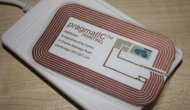
Impressive progress in printed electronics signals new market opportunities for printers
By Sean Smyth
With price pressure and volume reductions being forecast for print, the industry it is on the lookout for new opportunities. Adding electronic capability has been on the horizon for many years. After a hiatus instigated by the global slowdown, there are encouraging examples of how print might evolve to create new high-value print products.
The printing of products like packaging labels is now incorporating capability for adding electronic functionality directly to the printed media. In 2012 US Home Depot stores will introduce smart packaging from MeadWestvaco with integrated security tags. Such smart packaging applications are early examples of the opportunities available in printed electronics.
Progress
Two Cambridge companies have made impressive progress in the area. One is PragmatIC Printing, a Cambridge University spin-off looking to add interactivity to print products. One application is in security, allowing a consumer to authenticate a product by displaying a visual feature when touched, or placed near an RF source.
A PragmatIC interactive tag. The De La Rue logo appears when the tag is in close proximity to the RFID reader
The company has a development with De La Rue, the ‘Remotely Activated Interactive Labels’ (RAIL) project. No battery is required for the interactive labels: power is harvested wirelessly from a standard radio frequency ID or near-field communications reader.
Such readers are quickly becoming widespread – for example in contactless retail payment systems, or integrated into latest-generation of mobile phones. This means the labels can be extremely flexible and thin (around 50μ), and are also compatible with conventional hot lamination processes.
Another Cambridge company working to turn print into a two-way experience is Novalia. The start-up is taking a design-led approach to incorporating additional functionality into print. It is working in response to customer requests to grab attention, touch and interact, then educate.
Novalia talking book
Novalia has several prototypes that it has developed to demonstrate the capabilities of its technology. The company prints circuits and embeds components into printed items in a way that complements the design of a product or display.
Interactive
One example is a poster that depicts a drum kit. When touched, the integrated electronics can provide a range of sounds to make the drum kit interactive.









